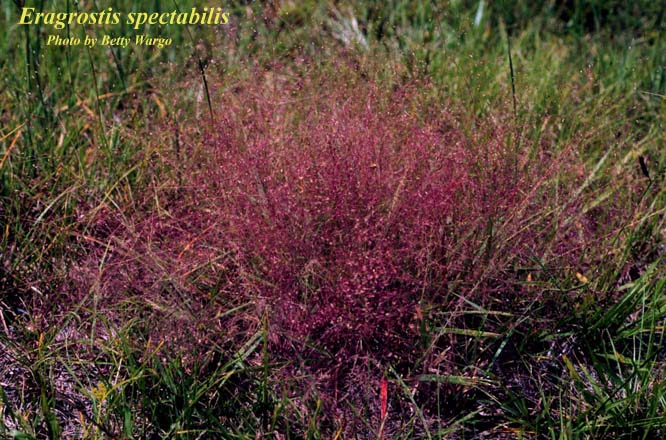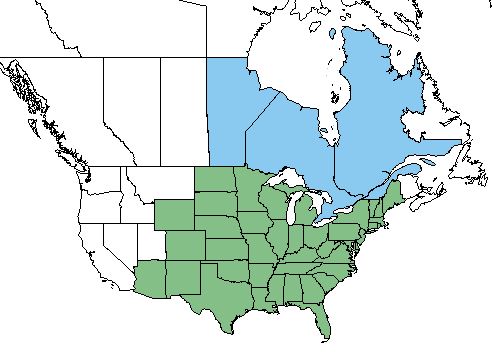Difference between revisions of "Eragrostis spectabilis"
(→Ecology) |
|||
| Line 33: | Line 33: | ||
===Habitat=== | ===Habitat=== | ||
Ideal habitats for ''E. spectabilis'' are sandy fields, roadsides, and woodlands. <ref name= "Weakley"> Weakley, A. S. (2015). Flora of the Southern and Mid-Atlantic States. Chapel Hill, NC, University of North Carolina Herbarium.</ref> | Ideal habitats for ''E. spectabilis'' are sandy fields, roadsides, and woodlands. <ref name= "Weakley"> Weakley, A. S. (2015). Flora of the Southern and Mid-Atlantic States. Chapel Hill, NC, University of North Carolina Herbarium.</ref> | ||
| + | |||
| + | Habitats for this species include wet pine flatwoods, dry sand open field, sandy vacant lots, pine woodlands, dry woods, upland pine oak woods, coarse sand regions with scrub barrens, and other disturbed areas such as roadsides and parking lots. <ref name = "FSU herbarium"> URL: http://herbarium.bio.fsu.edu. Last accessed: June 2018. Collectors: Loran Anderson, Cecil Slaughter, R.K. Godfrey, John Nelson, Gary Knight, H. Kurz, Robert Lazor, A.f. Clewell, George Cooley, Erdman West, Tom Daggy, R.E. Perdue Jr., A.H. Curtiss, Sidney McDaniel, R.Norris, R.Komarek, Karen MacClendon, Floyd Griffith) States and counties:Florida (Wakulla, Flagler, Franklin, Leon, Liberty, Gilchrist, Taylor, Bay, Palm Beach, Levy, Duval, Lafayette, Calhoun, Indian River, Washington, Holmes) Georgia (Thomas, Grady, Clinch, Atkinson)</ref> | ||
<!--Natural communities, human disturbed habitats, topography, hydrology, soils, light, fire regime requirements for removal of competition, etc.--> | <!--Natural communities, human disturbed habitats, topography, hydrology, soils, light, fire regime requirements for removal of competition, etc.--> | ||
<!--===Phenology===--> <!--Timing off flowering, fruiting, seed dispersal, and environmental triggers. Cite PanFlora website if appropriate: http://www.gilnelson.com/PanFlora/ --> | <!--===Phenology===--> <!--Timing off flowering, fruiting, seed dispersal, and environmental triggers. Cite PanFlora website if appropriate: http://www.gilnelson.com/PanFlora/ --> | ||
Revision as of 14:47, 14 June 2018
Common Names: Purple Lovegrass [1], Showy love grass [2], Tumblegrass [3]
| Eragrostis spectabilis | |
|---|---|

| |
| Photo by the Atlas of Florida Plants Database | |
| Scientific classification | |
| Kingdom: | Plantae |
| Division: | Magnoliophyta - Flowering plants |
| Class: | Liliopsida - Moncots |
| Order: | Poales |
| Family: | Poaceae |
| Genus: | Eragrostis |
| Species: | E. spectabilis |
| Binomial name | |
| Eragrostis spectabilis Pursh | |

| |
| Natural range of Eragrostis spectabilis from USDA NRCS Plants Database. | |
Contents
Taxonomic Notes
Synonym:E. spectabilis var. sparsihirsuta (Farwell)
Variety: none
Description
E. spectabilis is a perennial graminoid o the Poaceae family native to North America. [1]
Distribution
E. spectabilis is found throughout the majority of the 48 continental United States excepting the far west. It has also been introduced to eastern Canada. [1]
Ecology
Habitat
Ideal habitats for E. spectabilis are sandy fields, roadsides, and woodlands. [4]
Habitats for this species include wet pine flatwoods, dry sand open field, sandy vacant lots, pine woodlands, dry woods, upland pine oak woods, coarse sand regions with scrub barrens, and other disturbed areas such as roadsides and parking lots. [5]
Seed dispersal
The weak seedheads at the top of the grass stalks will break off and get dispersed by the wind. [1]
Fire ecology
Controlled annual burning is beneficial to the grass. It will increase if the region is annually burned. [1]
Use by animals
E. spectabilis is used by livestock for grazing in the spring. Deer will dig up the basal part of the stem and eat it during the winter. [1]
Conservation and Management
Cultivation and restoration
Photo Gallery
References and notes
- ↑ 1.0 1.1 1.2 1.3 1.4 1.5 USDA Plant Database
- ↑ Battaglia, L. L., et al. (2002). "Sixteen years of old-field succession and reestablishment of a bottomland hardwood forest in the lower Mississippi alluvial valley." Wetlands 22(1): 1-17.
- ↑ Robertson, K. R., et al. (1997). Delineation of natural communities, a checklist of vascular plants, and new locations for rare plants at the Savanna Army Depot, Carroll and Jo Daviess Counties, Illinois. Champaign-Urbana.
- ↑ Weakley, A. S. (2015). Flora of the Southern and Mid-Atlantic States. Chapel Hill, NC, University of North Carolina Herbarium.
- ↑ URL: http://herbarium.bio.fsu.edu. Last accessed: June 2018. Collectors: Loran Anderson, Cecil Slaughter, R.K. Godfrey, John Nelson, Gary Knight, H. Kurz, Robert Lazor, A.f. Clewell, George Cooley, Erdman West, Tom Daggy, R.E. Perdue Jr., A.H. Curtiss, Sidney McDaniel, R.Norris, R.Komarek, Karen MacClendon, Floyd Griffith) States and counties:Florida (Wakulla, Flagler, Franklin, Leon, Liberty, Gilchrist, Taylor, Bay, Palm Beach, Levy, Duval, Lafayette, Calhoun, Indian River, Washington, Holmes) Georgia (Thomas, Grady, Clinch, Atkinson)